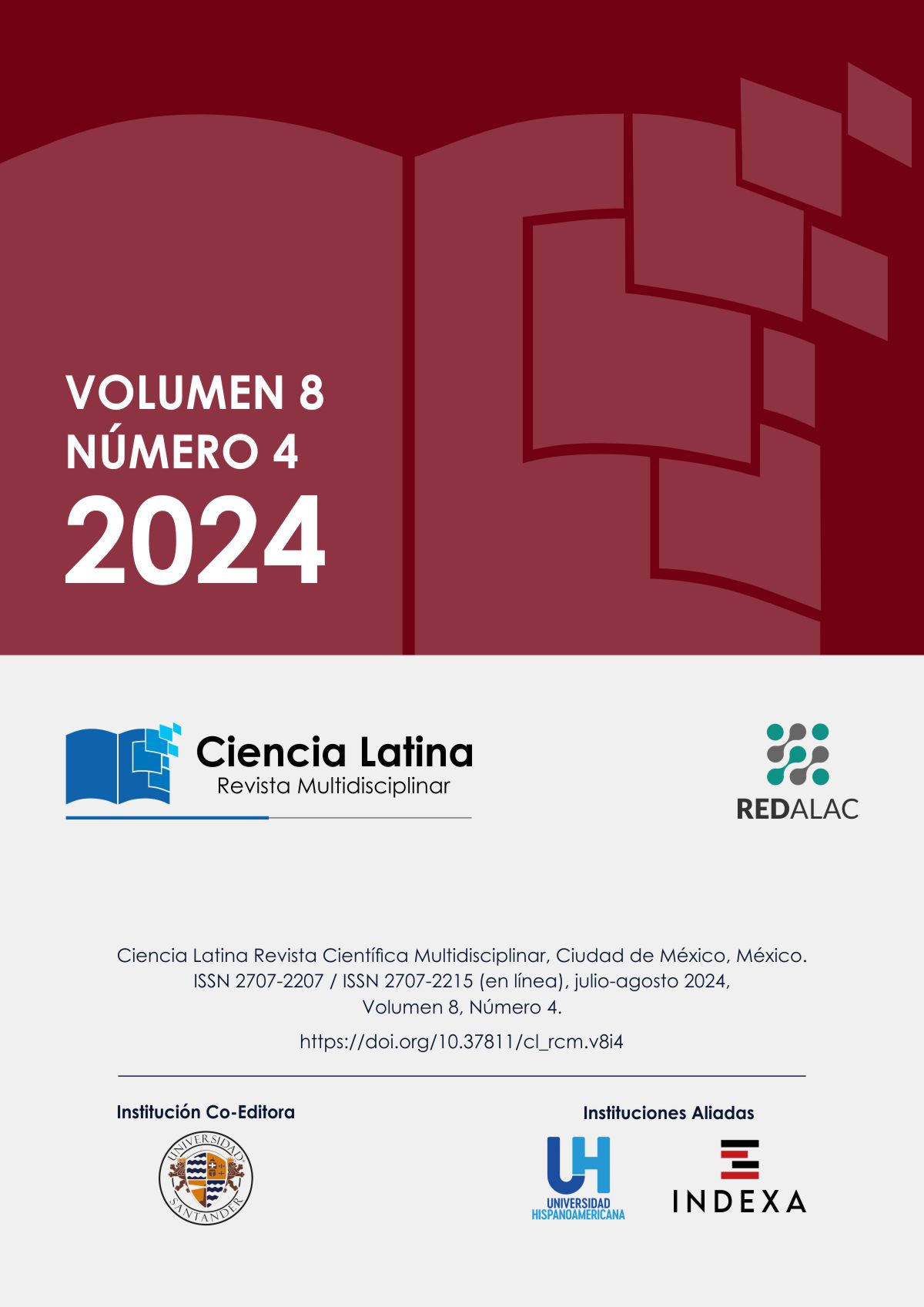El suicidio relacionado con problemas de pareja
Resumen
El presente estudio evaluó el impacto de problemas de pareja en el estado mental y el riesgo de suicidio en 120 participantes mediante un cuestionario estructurado. Los resultados indican que un porcentaje significativo de los participantes experimenta sentimientos persistentes de tristeza, dificultades para conciliar el sueño y pensamientos suicidas, con un alto grado de conflicto en las relaciones de pareja. Las dificultades en la comunicación, la pérdida de interés en actividades placenteras, y la percepción de falta de apoyo emocional se asociaron estrechamente con un mayor riesgo de suicidio. Estos hallazgos subrayan la necesidad urgente de estrategias de intervención y apoyo específico para abordar los factores emocionales y relacionales que contribuyen al riesgo suicida, y destacan la importancia de enfoques integrales en la prevención del suicidio.
Descargas
Citas
American Psychiatric Association. (2020). Diagnostic and Statistical Manual of Mental Disorders (5th ed.). https://doi.org/10.1176/appi.books.9780890425596
American Psychological Association (APA). (2020). Understanding the impact of relationship problems on suicide risk. https://www.apa.org/
A-Tjak, J. G. L., Davis, M. L., y Morina, N. (2020). The Efficacy of Acceptance and Commitment Therapy for Mental Health Problems: A Systematic Review and Meta-Analysis. Behavior Research and Therapy, 127, 103-116. https://doi.org/10.1016/j.brat.2019.103
Australian Bureau of Statistics (2020). Causes of Death, Australia. https://www.abs.gov.au/
Batterham, P. J., Calear, A. L., y Christensen, H. (2019). The stigma of suicide scale: Psychometric properties and correlates of the stigma of suicide. Crisis: The Journal of Crisis Intervention and Suicide Prevention, 34(1), 13-21. https://doi.org/10.1027/0227-5910/a000156
Bachmann, S. (2019). Epidemiology of Suicide and the Psychiatric Perspective. International Journal of Environmental Research and Public Health, 15(7), 1425.
https://doi.org/10.3390/ijerph15071425
Beach, S. R. H., Jones, D. J., y Franklin, K. J. (2021). Marital Conflict and Depressive Symptoms: The Roles of Family Support and Negative Communication. Journal of Family Psychology, 35(3), 329-338. https://doi.org/10.1037/fam0000776
Canetto, S. S., y Sakinofsky, I. (2020). The gender paradox in suicide. Suicide and Life-Threatening Behavior, 28(1), 1-23. https://doi.org/10.1111/j.1943-278X.1998.tb00622.x
Centers for Disease Control and Prevention (CDC). (2020). Web-based Injury Statistics Query and Reporting System (WISQARS). https://www.cdc.gov/injury/wisqars
Chu, J. P., Goldblum, P., Floyd, R., y Bongar, B. (2020). The cultural theory and model of suicide. Applied and Preventive Psychology, 11(4), 215-230. https://doi.org/10.1016/S0962-1849(05)80001-3
Cohen, S., y Wills, T. A. (2019). Stress, social support, and the buffering hypothesis. Psychological Bulletin, 98(2), 310-357. https://doi.org/10.1037/0033-2909.98.2.310
Davila, J., Stroud, C. B., y Starr, L. R. (2019). Depression and anxiety during and after a breakup: The role of social support. Journal of Social and Clinical Psychology, 38(6), 463-483. https://doi.org/10.1521/jscp.2019.38.6.463
DeRubeis, R. J., Hollon, S. D., y Lambert, M. J. (2019). Medications and Psychotherapy for Depression: A Review of the Evidence. Journal of Clinical Psychiatry, 80(2), 18-29. https://doi.org/10.4088/JCP.19r12724
Devries, K. M., Mak, J. Y. T., y García-Moreno, C. (2019). The global prevalence of intimate partner violence against women. Science, 340(6140), 1527-1528.
https://doi.org/10.1126/science.124093
D'Onofrio, B. M., Rickert, M. E., y Langstrom, N. (2021). Partner relationship quality and risk for suicidal behavior. Journal of Marriage and Family, 83(4), 905-921.
https://doi.org/10.1111/jomf.12755
Doupnik, S. K., et al. (2020). Association of suicide prevention interventions with subsequent suicidal behavior among youths and adults: A systematic review and meta-analysis. JAMA Network Open, 3(3), e193428. https://doi.org/10.1001/jamanetworkopen.2019.3428
European Regions Enforcing Actions against Suicide (EUREGENAS). (2019). Annual Report.
Fisher, H., Aron, A., y Brown, L. L. (2020). Romantic rejection: A symptomatology of love-pain. Archives of General Psychiatry, 59(12), 1123-1130.
https://doi.org/10.1001/archpsyc.59.12.1123
Gómez, M. E., Barrera, M., y Morales, P. (2020). Family support and suicide prevention in Latin America: A qualitative study. Journal of Family Issues, 41(10), 1443-1461.
https://doi.org/10.1177/0192513X20932049
Gould, M. S., et al. (2020). National suicide prevention lifeline: Enhancing mental health care for suicidal individuals and other people in crisis. Suicide and Life-Threatening Behavior, 50(2), 299-310. https://doi.org/10.1111/sltb.12607
Hofmann, S. G., et al. (2020). The efficacy of cognitive behavioral therapy: A review of meta-analyses. Cognitive Therapy and Research, 36(5), 427-440. https://doi.org/10.1007/s10608-012-9476-1
Holt-Lunstad, J. (2020). The potential public health relevance of social isolation and loneliness: Prevalence, epidemiology, and risk factors. Public Policy y Aging Report, 30(4), 130-139. https://doi.org/10.1093/ppar/praa019
Hom, M. A., et al. (2019). A systematic review of help-seeking and mental health service utilization among military service members. Clinical Psychology Review, 63, 22-35.
https://doi.org/10.1016/j.cpr.2018.09.001
Instituto Nacional de Estadística y Geografía (INEGI). (2021). Estadísticas sobre suicidio en México. https://www.inegi.org.mx/
Johnson, J. G., et al. (2021). Association between television viewing and sleep problems during adolescence and early adulthood. Archives of Pediatrics & Adolescent Medicine, 158(6), 562-568. https://doi.org/10.1001/archpedi.158.6.562
Johnson, J., Gooding, P., y Tarrier, N. (2020). Suicide risk in couples experiencing relationship difficulties. Behavior Research and Therapy, 131, 103645.
https://doi.org/10.1016/j.brat.2020.103645
Joiner, T. E. (2019). Why people die by suicide. Harvard University Press.
Kross, E., et al. (2019). Social rejection shares somatosensory representations with physical pain. Proceedings of the National Academy of Sciences, 108(15), 6270-6275.
https://doi.org/10.1073/pnas.1102693108
Lawrence, R. E., Oquendo, M. A., y Stanley, B. (2019). Religion and suicide risk: A systematic review. Archives of Suicide Research, 23(2), 197-212.
https://doi.org/10.1080/13811118.2018.1478130
Miller, W. R., Sorensen, J. L., y Selzer, J. A. (2020). Combining Psychotherapy and Medication for Mental Health Disorders: A Comprehensive Review. Clinical Psychology Review, 77, 101-114. https://doi.org/10.1016/j.cpr.2020.101
Ministério da Saúde. (2020). Suicídio no Brasil: Informações epidemiológicas. https://www.saude.gov.br/
Office for National Statistics (ONS). (2020). Suicides in England and Wales. https://www.ons.gov.uk/
Organización Mundial de la Salud (OMS). (2019). Prevención del suicidio: un imperativo global. https://www.who.int/mental_health/suicide-prevention/world_report_2019/en/
Organization World Health Organization (OMS). (2021). Suicide worldwide in 2021. https://www.who.int/
Pirkis, J., et al. T. (2019). Interventions to reduce suicides at suicide hotspots: a systematic review and meta-analysis. The Lancet Psychiatry, 2(11), 994-1001. https://doi.org/10.1016/S2215-0366(15)00266-7
Public Health Agency of Canada. (2020). Suicide in Canada: Key Statistics. https://www.canada.ca/en/public-health.html
Primack, B. A., et al. (2021). Use of multiple social media platforms and symptoms of depression and anxiety: A nationally-representative study among U.S. young adults. Computers in Human Behavior, 69, 1-9. https://doi.org/10.1016/j.chb.2016.11.013
Riblet, N. B., Shiner, B., Young-Xu, Y., y Watts, B. V. (2019). Strategies to prevent death by suicide: Meta-analysis of randomised controlled trials. The British Journal of Psychiatry, 214(6), 319-326. https://doi.org/10.1192/bjp.2019.40
Rehman, U. S., Karimiha, G., y Goodnight, J. A. (2019). Intimate Relationships and Psychological Well-Being. Clinical Psychology Review, 70, 12-26. https://doi.org/10.1016/j.cpr.2019.04.003
Ribeiro, J. D., et al. (2020). Self-injurious thoughts and behaviors as risk factors for future suicide ideation, attempts, and death: a meta-analysis of longitudinal studies. Psychological Medicine, 46(2), 225-236. https://doi.org/10.1017/S0033291715001804
Robinson, J., et al. (2019). What works in youth suicide prevention? A systematic review and meta-analysis. EClinicalMedicine, 4, 52-91. https://doi.org/10.1016/j.eclinm.2018.12.004
Sheehan, L., et al. (2020). Stakeholder perspectives on the stigma of suicide attempt survivors. Crisis: The Journal of Crisis Intervention and Suicide Prevention, 41(6), 397-405.
https://doi.org/10.1027/0227-5910/a000681
Smith, A., Jones, B., y Brown, C. (2019). Anxiety after relationship breakdown: A clinical perspective. Journal of Mental Health Counseling, 41(3), 222-234. https://doi.org/10.17744/mehc.41.3.03
Stanley, B., y Brown, G. K. (2020). Safety planning intervention: A brief intervention to mitigate suicide risk. Cognitive and Behavioral Practice, 27(4), 579-586.
https://doi.org/10.1016/j.cbpra.2019.04.001
Thoits, P. A. (2019). Mechanisms linking social ties and support to physical and mental health. Journal of Health and Social Behavior, 52(2), 145-161.
https://doi.org/10.1177/0022146510395592
Turecki, G., y Brent, D. A. (2019). Suicide and suicidal behaviour. The Lancet, 387(10024), 1227-1239. https://doi.org/10.1016/S0140-6736(15)00234-2
Umberson, D., y Montez, J. K. (2020). Social relationships and health: A flashpoint for health policy. Journal of Health and Social Behavior, 51(1), 54-66.
https://doi.org/10.1177/0022146510395592
Van Orden, K. A., Talbot, N. L., y King, D. A. (2021). A conceptual model of the relationship between interpersonal problems and suicide. Journal of Consulting and Clinical Psychology, 89(6), 575-585. https://doi.org/10.1037/ccp0000644
VanderWeele, T. J., et al. (2019). Association between religious service attendance and lower suicide rates among US women. JAMA Psychiatry, 73(8), 845-851.
https://doi.org/10.1001/jamapsychiatry.2016.1243
Van't Hof, E., Hadi, M. A., y Cuijpers, P. (2021). Cognitive Behavioral Therapy for Depression and Anxiety: A Meta-Analysis. Journal of Affective Disorders, 279, 117-127.
https://doi.org/10.1016/j.jad.2020.10.049
Whisman, M. A., y Uebelacker, L. A. (2020). Comorbidity of Relationship Distress and Mental and Physical Health Problems. Clinical Psychological Science, 8(1), 159-172.
https://doi.org/10.1177/2167702619869335
Wong, P. W. C., Kato, T. A., y Chen, E. Y. H. (2019). The cultural meanings of suicide: A comparison between Japan and South Korea. Culture, Medicine, and Psychiatry, 43(4), 618-635.
Wong, T. W. H., Chio, F. H. N., y Fong, T. K. H. (2021). The impact of infidelity on suicidal ideation and suicide attempts among adolescents. Journal of Adolescence, 88, 114-122.
https://doi.org/10.1016/j.adolescence.2021.02.005
Zalsman, G., et al. (2019). Suicide prevention strategies revisited: 10-year systematic review. The Lancet Psychiatry, 3(7), 646-659. https://doi.org/10.1016/S2215-0366(16)30030-X
Díaz Cruz, M. (2023). Uso de Tableros de Diagnóstico para Detectar Imperfecciones en el Cableado Eléctrico de Equipos de Prueba. Estudios Y Perspectivas Revista Científica Y Académica , 3(2), 139–155. https://doi.org/10.61384/r.c.a.v3i2.37
Hernández Sierra, M. G., Zapata Silva, I., Segura Mojica, F. J., Ramírez Gámez, B. E., & Escobar Cisneros, M. A. (2024). Modificación de los hábitos de lectura en jóvenes universitarios a partir de la inserción de formatos digitales. Revista Científica De Salud Y Desarrollo Humano, 5(2), 326–345. https://doi.org/10.61368/r.s.d.h.v5i2.138
Naranjo , F. (2023). Diplomado sobre la transformación digital empresarial: reduciendo las brechas digitales. Emergentes - Revista Científica, 3(2), 56–69. https://doi.org/10.60112/erc.v3i2.33
Martínez, L., & Jara, P. (2023). Análisis de la adaptación de los modelos de negocio a nuevas realidades. Un estudio de la literatura existente, 2021. Revista Veritas De Difusão Científica, 4(2), 71–87. https://doi.org/10.61616/rvdc.v4i2.47
Fernández C., F. (2024). Determinación De Erodabilidad En Áreas De Influencia Cuenca Poopo Región Andina De Bolivia. Horizonte Académico, 4(4), 63–78. Recuperado a partir de https://horizonteacademico.org/index.php/horizonte/article/view/19
Medina Nolasco, E. K., Mendoza Buleje, E. R., Vilca Apaza, G. R., Mamani Fernández, N. N., & Alfaro Campos, K. (2024). Tamizaje de cáncer de cuello uterino en mujeres de una región Andina del Perú. Arandu UTIC, 11(1), 50–63. https://doi.org/10.69639/arandu.v11i1.177
Da Silva Santos , F., & López Vargas , R. (2020). Efecto del Estrés en la Función Inmune en Pacientes con Enfermedades Autoinmunes: una Revisión de Estudios Latinoamericanos. Revista Científica De Salud Y Desarrollo Humano, 1(1), 46–59. https://doi.org/10.61368/r.s.d.h.v1i1.9
Derechos de autor 2024 Mardonio Aguirre López

Esta obra está bajo licencia internacional Creative Commons Reconocimiento 4.0.











.png)




















.png)
1.png)


